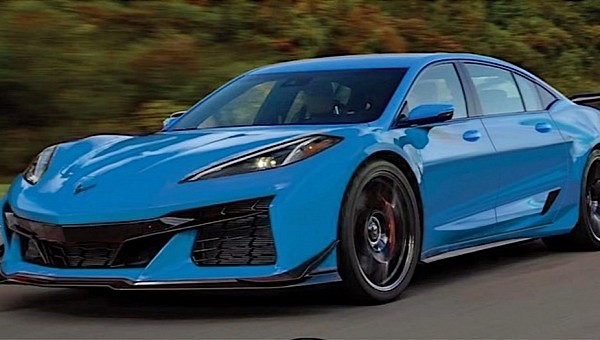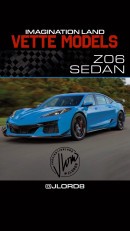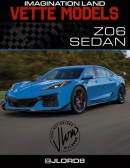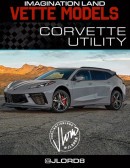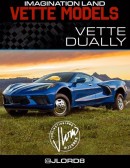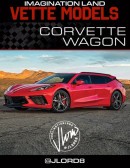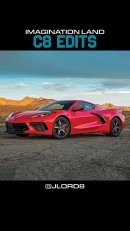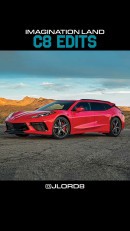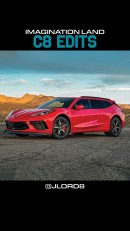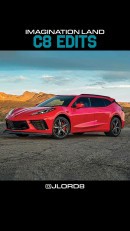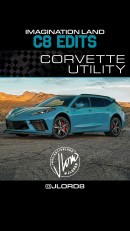Recent rumors that General Motors is about to create a sub-brand around the Corvette nameplate that includes EVs, sedans and SUVs may have seemed farfetched as little as a few years ago. But given the rapid changes in the industry, such a move seems to be more likely than not.
While a mid-engine Corvette was bandied about since the late 1960s, cost and purist objections kept it from happening until the C8, which has proven to be a success. No small part of that success goes to designer Tom Peters, who set the table for this major shift to a midship engine with the radical redesign of the front-engine C7.
Emboldened by the acceptance of the C8 by the Corvette faithful as well as the car’s ability to attract new buyers to the brand, Chevrolet is promising electrified versions of the car in both hybrid and pure electric iterations. This shift in technology as well as the overwhelming popularity of SUV body styles also opens the door to explore new Corvette variants.
Porsche made this all possible by building its first SUV in the Cayenne. Despite the hue and cry of Porschephiles who believed the only real Porsche had two doors and an engine hung aft the rear axle, the German automaker, which had struggled with profitability, found firm footing from the strong sales of the Cayenne. It went on to add a second in the smaller Macan, a four-door sedan in the Panamera and an all-electric in the Taycan.
Other luxury and exotic brands followed suit, from Bentley with its Bentayga to Lamborghini with the Urus (though give Lambo credit for being an SUV pioneer with the LM002). Even Ferrari, which stated many times categorically that it would not build an SUV has now surrendered and will built its first in the Purosangue. Back closer to earth, Ford also proved that the Mustang nameplate is no longer tied directly to the two-door pony car segment, that it too can use sporty styling and its evocative heritage on an electric SUV in the Mustang Mach-E.
All of this certainly has laid the groundwork for an expanded Corvette brand. But in a way, perhaps Corvette is returning to its roots. After the two-seat roadster was introduced in 1953, GM built a series of concepts around the Corvette in 1954 for its traveling Motorama exhibits it staged during the decade. In addition to the roadster, variants include a hardtop coupe, fastback and shooting brake style two-door station wagon, the Nomad, which eventually made it into production based on a larger standard Chevrolet chassis. In fact, the Nomad wagon probably owes more in styling to today’s SUVs than traditional sedans and coupes.
Chevrolet also toyed with a four-passenger version of the C2 Corvette in the mid-1960s, though the ungainly proportions that resulted contributed to the decision not to build it.
Perhaps the idea of a Corvette sub-brand with multiple body styles was an idea that was just way ahead of its time. Back then, there was a clear demarcation between function, design and application of vehicle types. Cars were for carrying people, trucks were for hauling stuff.
Over the years, as the line has blurred between cars and trucks with the rise of both SUVs and pickups as family transportation, so also will the line traditional internal combustion and electrification as power sources. This redefinition opens up the new possibilities, as we have seen with a wide range of brands, to embrace new approaches to meeting the needs of their customers.
While some purists may want to stand in the way of these changes, they’ll soon discover what’s seemingly impossible is more likely inevitable.
Emboldened by the acceptance of the C8 by the Corvette faithful as well as the car’s ability to attract new buyers to the brand, Chevrolet is promising electrified versions of the car in both hybrid and pure electric iterations. This shift in technology as well as the overwhelming popularity of SUV body styles also opens the door to explore new Corvette variants.
Porsche made this all possible by building its first SUV in the Cayenne. Despite the hue and cry of Porschephiles who believed the only real Porsche had two doors and an engine hung aft the rear axle, the German automaker, which had struggled with profitability, found firm footing from the strong sales of the Cayenne. It went on to add a second in the smaller Macan, a four-door sedan in the Panamera and an all-electric in the Taycan.
Other luxury and exotic brands followed suit, from Bentley with its Bentayga to Lamborghini with the Urus (though give Lambo credit for being an SUV pioneer with the LM002). Even Ferrari, which stated many times categorically that it would not build an SUV has now surrendered and will built its first in the Purosangue. Back closer to earth, Ford also proved that the Mustang nameplate is no longer tied directly to the two-door pony car segment, that it too can use sporty styling and its evocative heritage on an electric SUV in the Mustang Mach-E.
All of this certainly has laid the groundwork for an expanded Corvette brand. But in a way, perhaps Corvette is returning to its roots. After the two-seat roadster was introduced in 1953, GM built a series of concepts around the Corvette in 1954 for its traveling Motorama exhibits it staged during the decade. In addition to the roadster, variants include a hardtop coupe, fastback and shooting brake style two-door station wagon, the Nomad, which eventually made it into production based on a larger standard Chevrolet chassis. In fact, the Nomad wagon probably owes more in styling to today’s SUVs than traditional sedans and coupes.
Chevrolet also toyed with a four-passenger version of the C2 Corvette in the mid-1960s, though the ungainly proportions that resulted contributed to the decision not to build it.
Perhaps the idea of a Corvette sub-brand with multiple body styles was an idea that was just way ahead of its time. Back then, there was a clear demarcation between function, design and application of vehicle types. Cars were for carrying people, trucks were for hauling stuff.
Over the years, as the line has blurred between cars and trucks with the rise of both SUVs and pickups as family transportation, so also will the line traditional internal combustion and electrification as power sources. This redefinition opens up the new possibilities, as we have seen with a wide range of brands, to embrace new approaches to meeting the needs of their customers.
While some purists may want to stand in the way of these changes, they’ll soon discover what’s seemingly impossible is more likely inevitable.
